Six Amazing Freshwater Dive Sites
Merely 3 percent of the water on Earth is fresh water, and about two-thirds of that is found in glaciers, polar ice caps, the atmosphere and soil. Only a negligible amount of the remaining 1 percent offers the crystal-clear ecosystems that so much life depends on, in perpetual fragile balance with the surrounding grounds. Fresh waters harbor a greater concentration of life than terrestrial and ocean biomes. They provide habitat for more than 10 percent of known animals and about one-third of all known vertebrate species. But, in addition to their ecology, fresh waters hold spectacular sceneries, colors and forms, along with unique challenges and rewards for divers and underwater photographers.
Mato Grosso Do Sul, Brazil
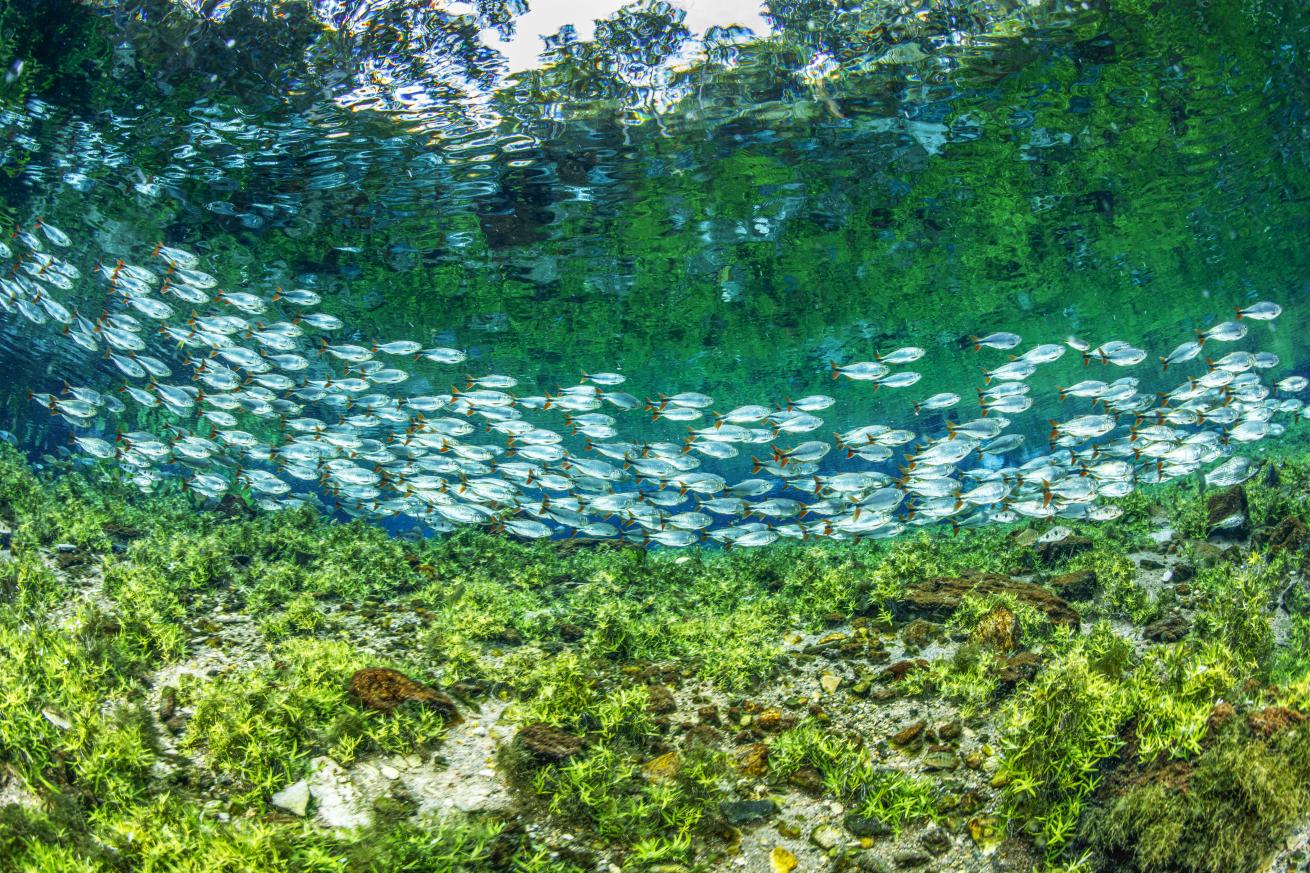
Franco BanfiA school of piraputanga passes close to the surface at Nascente Azul, Brazil.
The aquatic heart of South America is a bit like a giant sponge, a seemingly endless mosaic of rivers, lakes, ponds, swamps, islets, forest, scrub and wooded savanna, or cerrado. In some rivers there are waterfalls and caves, hidden by thick jungle. To explore the area, I rented a small aluminum boat loaded with my equipment and paddled for a few miles along the river.
This vast spiderweb of water and impenetrable swamps hosts prehistoric reptiles (caimans), many species of fish and even freshwater stingrays, animals that I was surprised to learn exist. Much like their ocean-dwelling relatives, they are rather shy and display benthonic behaviors. They have developed an impressive ability to blend with the substrate through a nearly perfect camouflage, lying motionless and waiting for their prey.
While snorkeling in Rio da Prata, I approached and observed several species of freshwater fishes, including piraputanga, dourado, pacu, cachara and the so-called matogrosso, a small scarlet-red fish. Many resembled catfish, carps and trout. These fishes play a major role in the biocenosis that holds the ecosystem together, especially those that are frugivorous (fruit-eating) since they are considered effective seed dispersers.
The voracity of the piraputanga, which plays the role of both predator and prey, and the carnivorous dourado—a vicious predator with powerful jaws and a mouth filled with sharp teeth—was on full display for me while diving these waters. Due to the karst topography and enormous amount of porous limestone in the ground, the water in this area passes through a natural filter, making these rivers some of the clearest and most
Need To Know
Dive Conditions: Water temps range from the high 60s to low 70s. Visibility is great in the karstic rivers and springs but especially poor in the ponds where dying vegetation covers the ground.
When To Go: Late August to early October is the best period because of the green vegetation and animals coming out of their hides in search of food.
Operator: Bonito is a remote destination and organizing a guided tour is recommended; Recanto Ecologico Rio da Prata
Iceland
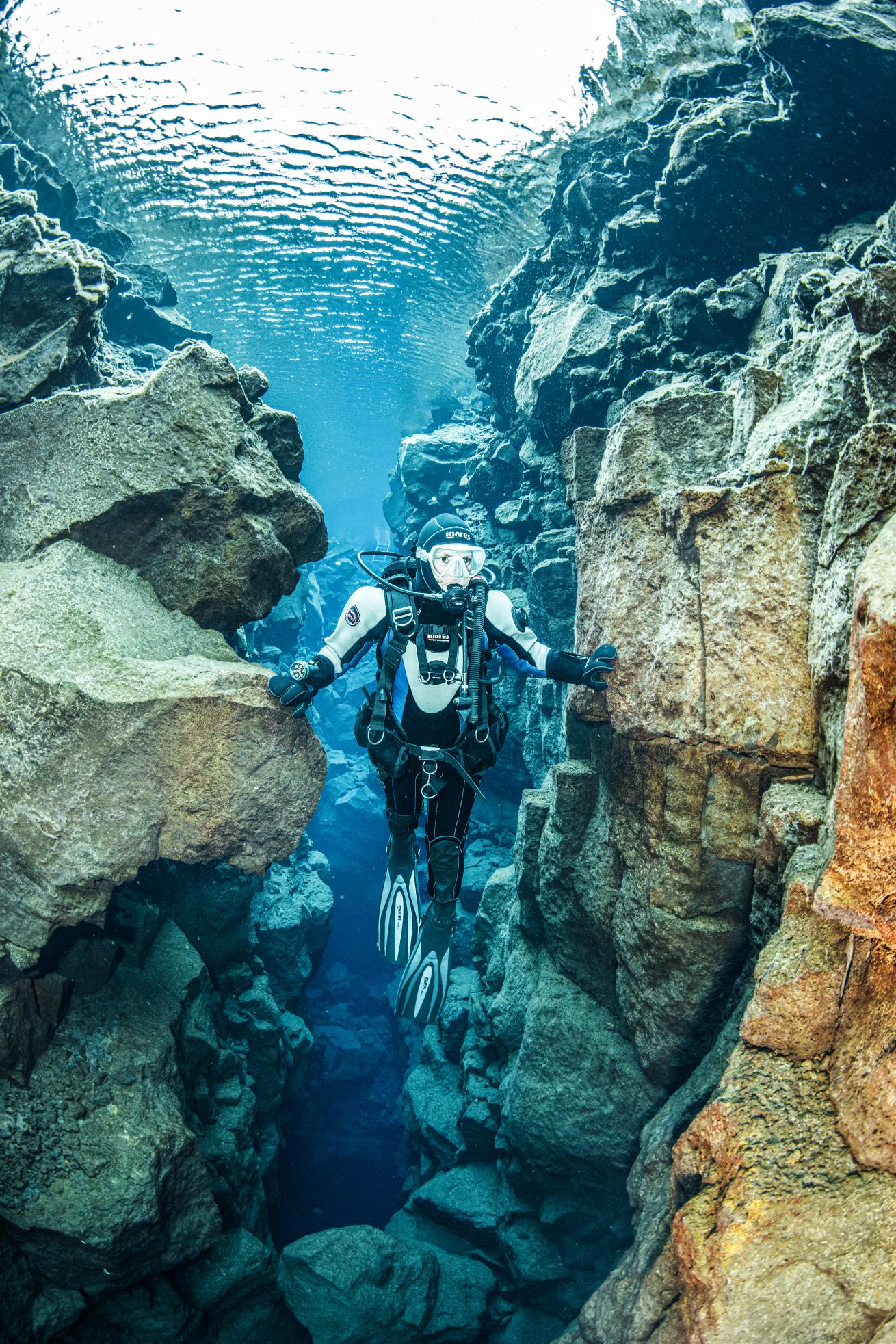
Franco BanfiA diver submerges at Silfra crack between the North American and Eurasian tectonic plates.
Known as the “land of fire and ice,” this Northern European island shelters many unknown and never-dived spots, plus a few special places that can be dived over and over, always presenting something fresh and new.
Crystal-clear blue is the dominant color of freshwater dives in Iceland. The two best-known sites, Silfra and Davíðsgjá, are divable fissures in Thingvellir National Park, where the Eurasian and North American tectonic plates are drifting apart at a rate of about 2 centimeters per year. There’s also Nesgjá, a pure gem in the northern reaches of the country.
And then there are the real “secret spots,” nameless fissures loved by local divers but rarely visited by tourists. To access some of them you need helicopters or “superjeeps,” vehicles that can climb Iceland’s mountainous lunar landscape and transport equipment once the snow level subsides.
But this journey can still be uncomfortable for divers. There are no refill stations, no buildings in which to take shelter from the blowing winds, and no shops to service gear in the event of an equipment failure. There is only wild nature, no frills: desert lava rocks covered with lichens, innumerable craterous lakes hidden in the wildest part of the country, and lava fissures filled with pure clear water.
These are among the most amazing places I’ve dived. With no other divers around but my buddy and guide, we spent hours cherishing the beauty of the mirrored surface and the tricks of light on the stunning tectonic sceneries. Diving in this region requires familiarity with drysuits and cold-water diving, as well as exceptional trim and buoyancy control, but for the properly trained diver, these spots evoke a sense of calmness and relaxation—ultimate freedom in the pale blue.
Need To Know
Dive Conditions: Water temps range from about 33 to 40 degrees year-round, with visibility reaching above 300 feet. Most of the sites are shallow, with no significant current. A drysuit is a must. Find well-fitting gloves with good thermal protection, such as 7 mm three-finger wet gloves or dry gloves with warm under-gloves.
When To Go: Take advantage of the long daylight hours from late April to early October, but try to avoid peak high season in the summer months.
Operator: Guided tours with operators, such as Dive.is out of Reykjavík, are strongly recommended.
Capo D’Acqua, Italy
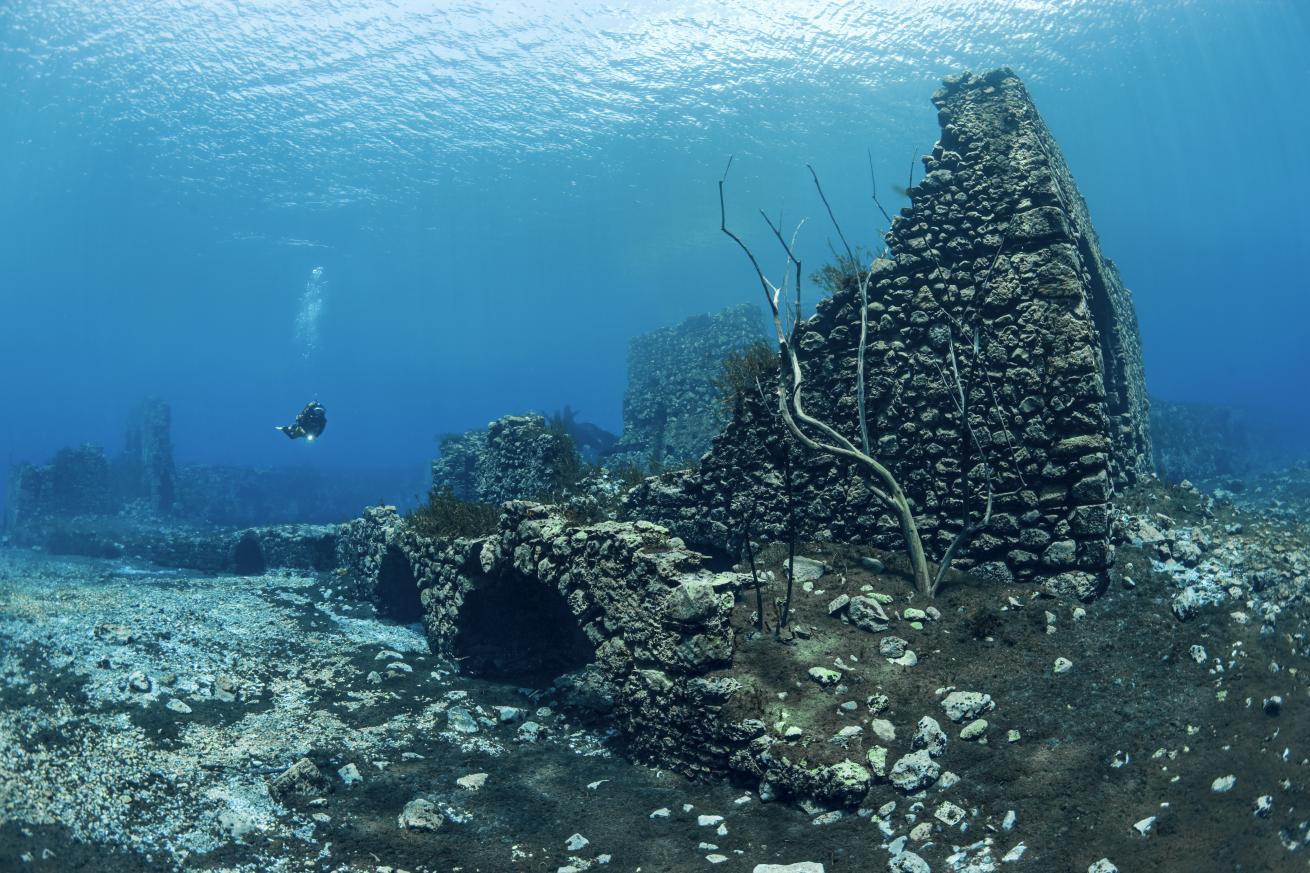
Franco BanfiClear, fresh water makes for excellent visibility around the flooded ruins of a mill at Capo d’Acqua Lake in Abruzzo, Italy.
Located near the town of Capestrano, in Italy’s Abruzzo region, this lake materializes like a transparent turquoise mirage as you approach it on a short, flower-lined country road.
Capo d’Acqua Lake was created in the 1950s, when the valley was purposely flooded to provide an irrigation source for the surrounding farmland. Centuries before it was flooded, the site was home to medieval houses, streets and bridges, as well as two watermills and a paint factory. Today half of this building can still be seen above the surface. The remains of the two mills are entirely submerged.
The excellent viz and shallow depth (about 30 feet max) allow divers to admire the layout of the town and explore the submerged buildings, the dry stone walls, the remains of paved paths, and the frames of underwater trees with outstretched branches in unnatural positions.
One of the mills still has walls with interesting architectural details. Only the foundation remains of the other one, with the metal blades of the water wheel still visible.
In general, the city’s walls are far from being intact, mostly due to earthquakes, but the ruins are extensive enough that you’ll need a full hour of diving to explore them properly. Luckily, bottom time is not a problem due to how shallow the dive is.
Need To Know
Dive Conditions: Water temperature is a constant 50 degrees year-round. Drysuits are recommended. Visibility is nearly unlimited. Make sure to fin-kick correctly, be appropriately weighted, and in total control of your buoyancy to avoid disturbing the ruins.
When To Go: Year-round.
Operator: Diving can only be arranged through Atlantide Dive Center, which holds the sole rights to offer guided tours of the privately owned lake. Its trained staff must lead all dives. Make sure to book in advance.
Lake Baikal, Russia
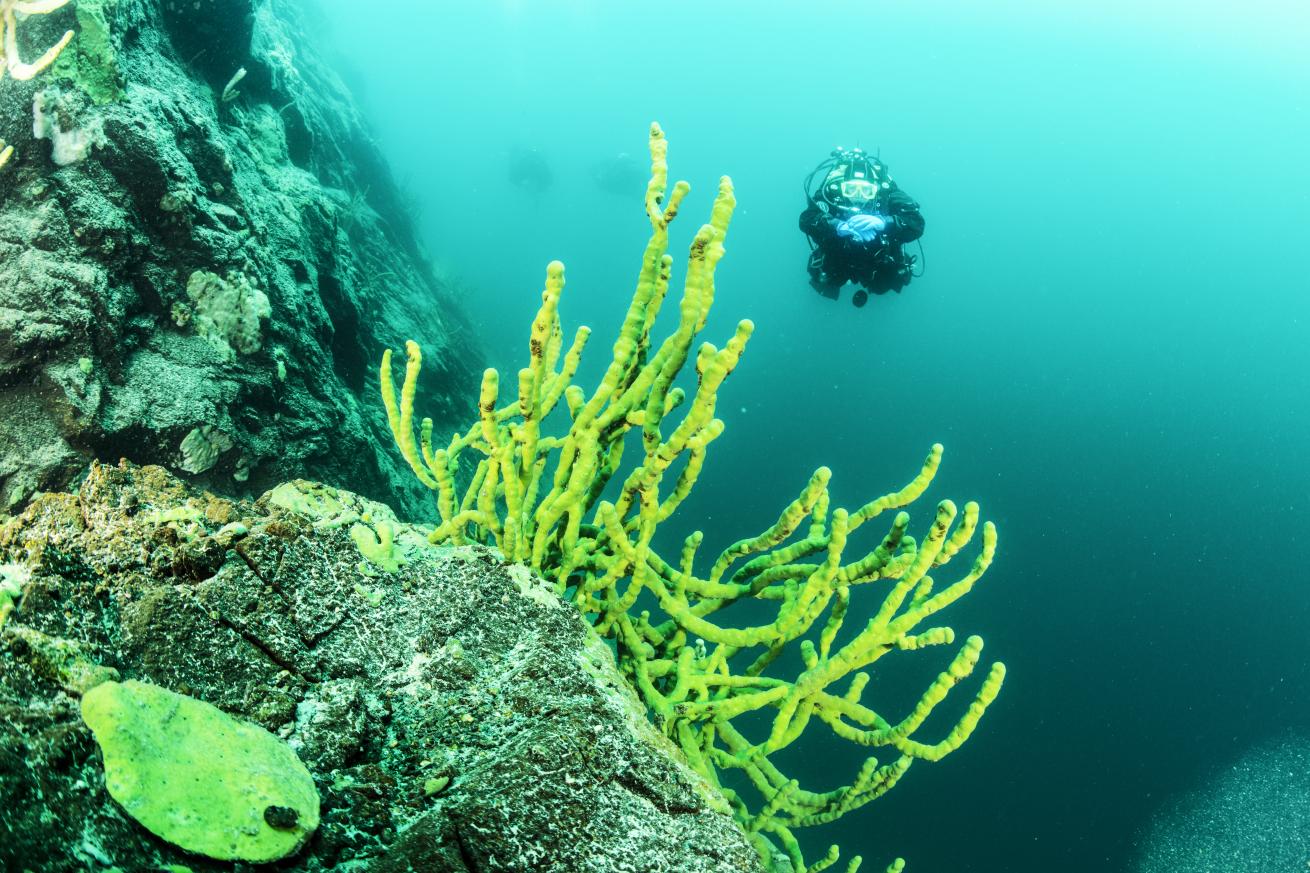
Franco BanfiLubomirskia baicalensis is a sponge endemic to Lake Baikal; the endemic amphipod Parapallasea sitnikovae.
Lake Baikal, located in southern Siberia, is the deepest (5,387 feet) and oldest lake on Earth—more than 25 million years old. It’s the largest lake by volume, and seventh-largest by surface area. This massive body of water contains about 20 percent of the available fresh water on the planet.
My experience in Baikal was different from any other freshwater basins I’ve dived because of the high cliffs and deep walls generated by the rift valley where the earth’s crust is slowly pulling apart.
Neon-green lights are omnipresent: A forest of large green sponges covers a green base of soft mosses and lichens everywhere you look. Many of the large sponges have been colonized by small, psychedelically colored arthropods with far too many legs.
There are more than 350 species and subspecies of amphipods here, and all are endemic. They are exceptionally diverse in ecology and appearance, ranging from the pelagic Macrohectopus to the relatively large deepwater Abyssogammarus. The “gigantism” of some Baikal amphipods, which has been compared to that seen in Antarctic amphipods, has been linked to the high level of dissolved oxygen in the lake. About two-thirds of some 1,500 animals and 1,000 plant species are endemic. Notably, one of the world’s two freshwater seal species lives in Lake Baikal: the nerpa, also called the Baikal seal.
The lake boasts 52 species of fish, 27 of which are endemic, such as the omul (Coregonus migratorius), a whitefish species of the salmon family. The most prevalent species is the golomyanka. It inhabits deeper waters than any other freshwater fish in the world and has managed to preserve its eyesight even at the greatest depths, although it only sees in black and white.
Need To Know
Dive Conditions: Lake Baikal is considered tec diving. Regulators should be frost-protected; BC inflators should be serviced to withstand freezing. In the warmest season (August to September),water temps average around 50 degrees at the surface and fall to 40 at depth. Drysuit strongly recommended. Visibility reaches 130 feet in summer and can fall to 30 feet in March.
When To Go: Mid-May to November for an ice-free surface.
Operator: Baikal Tek, Irkutsk
Crystal River, Florida
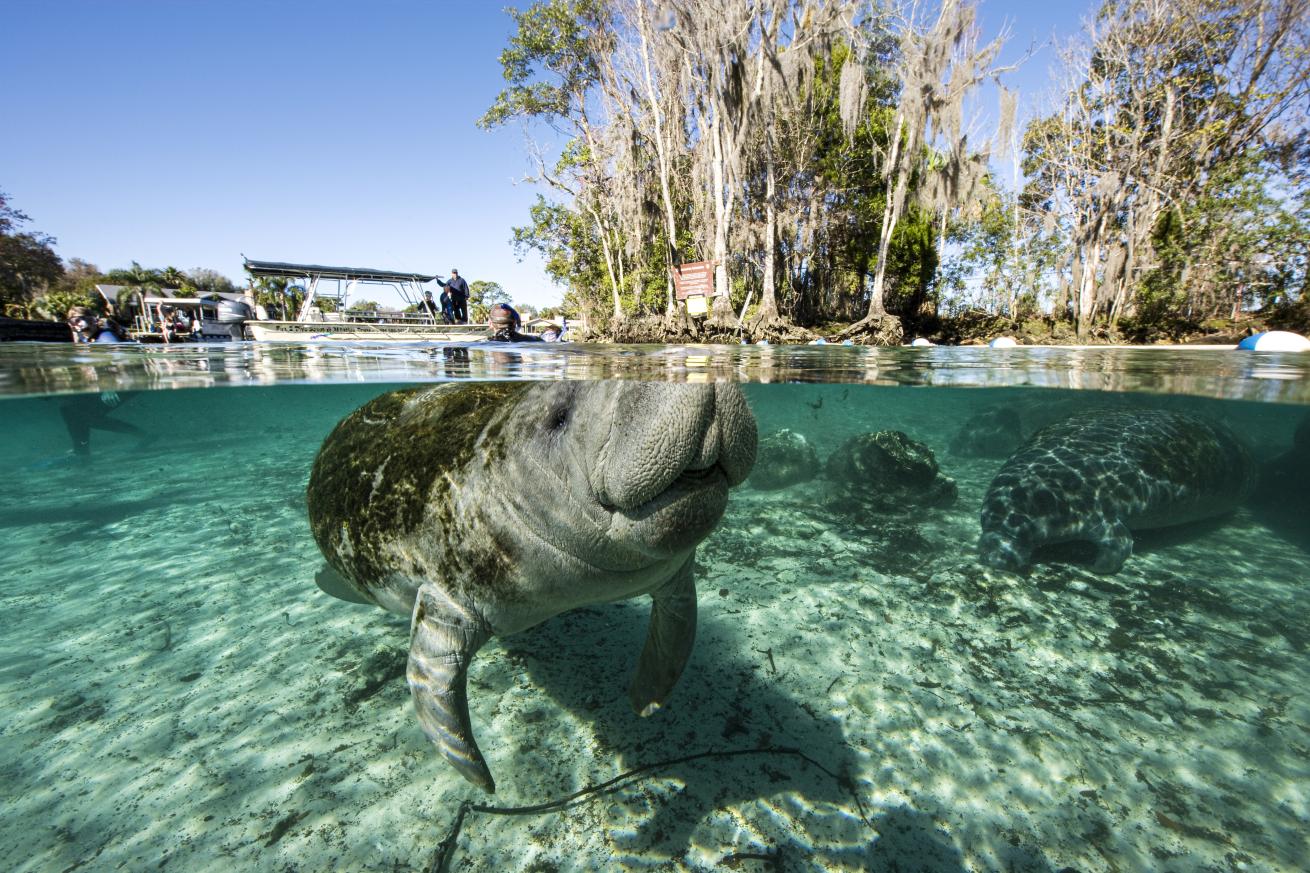
Franco BanfiA Florida manatee at Crystal River.
It’s all about manatees here at Crystal River National Wildlife Refuge in Citrus County (an hour and a half north of Tampa by car), where waters from Kings Bay feed a collection of springs.
From November to April, Florida manatees (Trichechus manatus latirostris) migrate from the Gulf of Mexico through canals and rivers to escape colder water and naturally aggregate here to warm up.
They might resemble seals or walruses, but their closest relatives are elephants! Manatees are the largest herbivorous marine mammal, and are known for their gentle demeanor.
Manatees can choose to rest inside the sanctuaries marked off by ropes and buoys where nobody is allowed to enter, or swim outside the floating barriers, approaching snorkelers or doing their own thing. There are strict rules against touching or otherwise harassing the manatees, which are protected by state and federal law. Give them space to move, and if a manatee avoids you, do not chase it for a closer interaction.
There is no water access to Three Sisters Springs from land. The best way is to kayak in with all your gear, launching from Hunter Springs Park or Pete’s Pier. The water here is so clear that I could see as many as 10 manatees at a time and enjoyed coming face to drooping face with these docile creatures.
Some rested like giant blimps on the river’s bottom, but many were occupied with the snorkelers. One of the manatees seemed especially smitten with an underwater photographer. It laid on the bottom of the river, wrapping its flippers around the photographer’s leg to hold him close. Another manatee, fascinated by the photographer’s camera, repeatedly poked his soft, gray snout at the lens.
Need To Know
Dive Conditions: The spring-fed headwaters of Crystal River are 72 degrees year-round. Visibility ranges from 30 to 100 feet.
When To Go: December to February for your best chance to see manatees. The colder, the better. Try to avoid crowds on weekends and holidays.
Operator: There are several companies in the Crystal River area, like Bird’s Underwater Dive Center, that will take you and a group out for a snorkel tour, but you can go without a company. Make sure to check the tide schedules before heading out.
Riviera Maya, Mexico
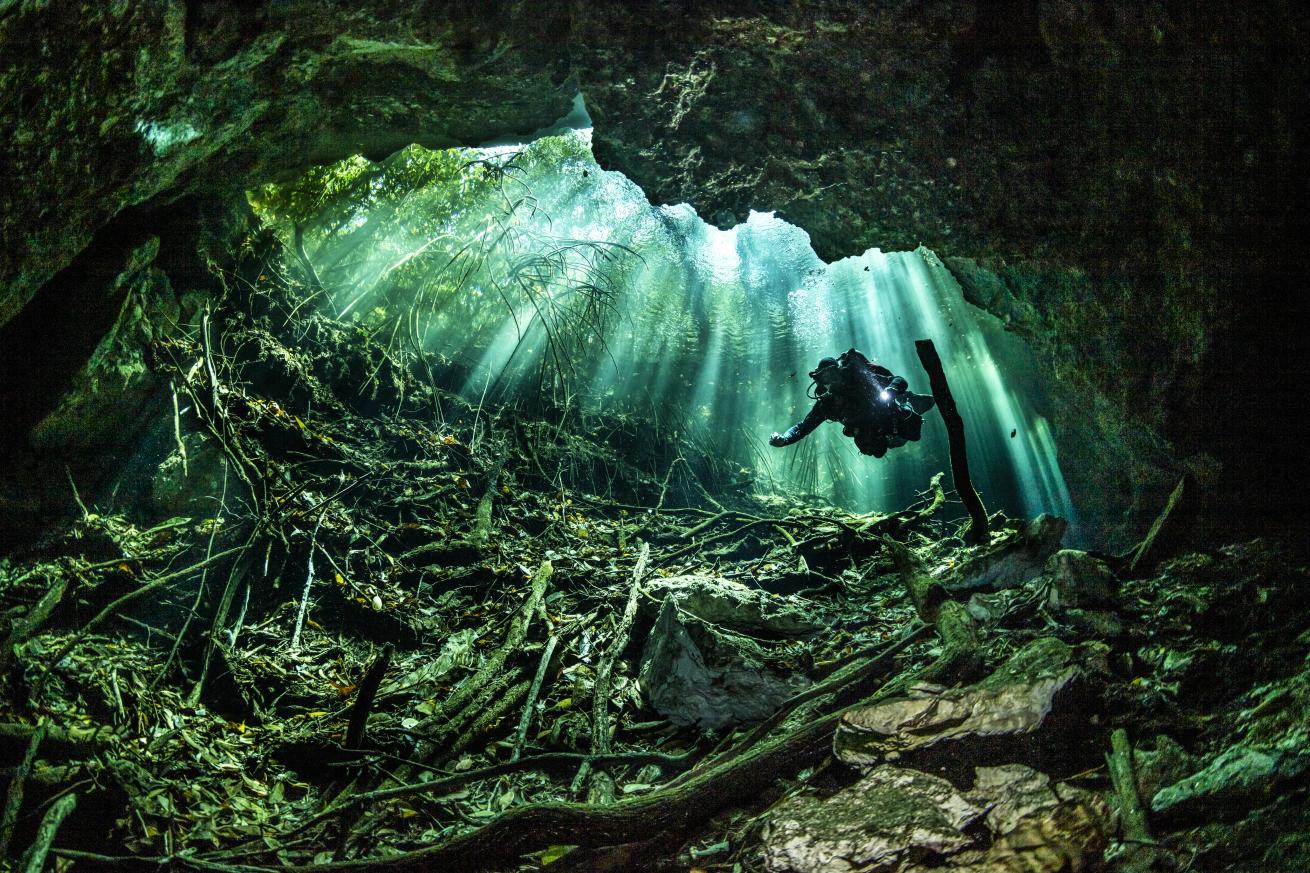
Franco BanfiThe green jungle can be viewed through an opening at the top of a cenote in the Tajma Ha system, about 16 miles south of Playa del Carmen, Mexico.
Below the tropical jungle of the Riviera Maya is a Swiss cheese-like underground river system. For thousands of years, the porous karst land surface, formed by fossilized coral and limestone, has filtered rainwater, which dissolved parts of the subsoil. The process created the largest network of caverns and underground rivers in the world.
Cenotes are formed when the roof of a cavern collapses due to erosion. The stalactites and stalagmites that form inside are natural works of art. In many cenotes, holes in the ceiling allow the sunlight to filter inside, giving the scene an eerie, otherworldly quality.
Cenote Angelita, about 50 miles southwest of Playa del Carmen, is a dive site like no other. I set up my gear and walked through the jungle until I reached what appeared to be a pond, perhaps 100 feet in diameter. The mosquitoes were bad, and no one hesitated to jump in the water to escape them.
We descended 30 feet in low visibility, through water turned reddish-brown due to tannic acid from the soil and nearby vegetation. Suddenly the water turned transparent, and we continued another 65 feet toward the tops of leafless tree branches that appeared to emerge from clouds below us.
This white mist is actually a hazy layer of hydrogen sulphide, which enveloped us until we exited the other side at 115 feet. Here, the blurry oil-and-water effect of the halocline—where fresh water on top and dense salt water beneath converge in layers—blurred our vision for a moment until, at about 130 feet, viz turned clear again.
The weight of hydrogen sulphide causes it to sink below the fresh water, giving it the appearance of another body of water. Trees, leaves, and other debris cover the “banks” at the bottom of the freshwater layer, which resemble a riverside. The layer of hydrogen sulphide is visible and able to move independently, thus appearing as a river with its own current.
Need To Know
Dive Conditions: Water temperature is consistent at about 77 degrees year-round. Average viz is about 100 feet, but it is disrupted by the misty layer of hydrogen sulfide. There are no currents or waves.
When To Go: Year-round. It’s best seen between midmorning and midafternoon, when the sun shines down from directly overhead.
Operators: Yukatek Divers; Cave Training Mexico










